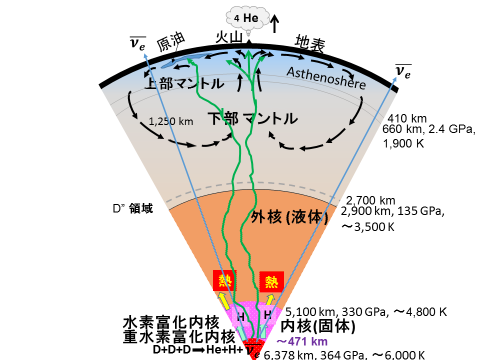地球内核内の核融合による熱生成の可能性
Possible generation of heat from nuclear fusion in Earth’s inner core
2016年11月23日 Scientific Reports 6 : 37740 doi: 10.1038/srep37740

地球内部から放出される熱の決定的な原因と発生源についてはまだ分かっていない。熱は放射性崩壊や地球原子炉により供給されていると提案している研究グループもある。本論文では、熱の生成は核の中心にある六方晶系FeDx結晶内に閉じ込められた重陽子の三体核融合の結果であるという仮説を提案する。この反応速度は、高圧(約364GPa)および高温(約5700K)の複合引力効果と、中性パイ中間子(パイオン)(2D + 2D + 2D → 21H+4He +  + e- + 21.63 MeV)による物理的触媒により増幅される。熱生成速度は、地球の始原的な熱供給はすでに終わっているという仮定に基づいて、1.27 × 1015 J/m3と計算される。生成されたH原子は内部核のH凝集領域でFe-H系合金として固溶され、He原子は地球内部から宇宙へと放出され、反電子ニュートリノ
+ e- + 21.63 MeV)による物理的触媒により増幅される。熱生成速度は、地球の始原的な熱供給はすでに終わっているという仮定に基づいて、1.27 × 1015 J/m3と計算される。生成されたH原子は内部核のH凝集領域でFe-H系合金として固溶され、He原子は地球内部から宇宙へと放出され、反電子ニュートリノ は、地球内部を通過する。
は、地球内部を通過する。
Corresponding Author
The cause and source of the heat released from Earth’s interior have not yet been determined. Some research groups have proposed that the heat is supplied by radioactive decay or by a nuclear georeactor. Here we postulate that the generation of heat is the result of three-body nuclear fusion of deuterons confined in hexagonal FeDx core-centre crystals; the reaction rate is enhanced by the combined attraction effects of high-pressure (~364 GPa) and high-temperature (~5700 K) and by the physical catalysis of neutral pions: 2D + 2D + 2D → 21H + 4He + e- +  + 21. 63 MeV. The possible heat generation rate can generation rate can be calculated as 1.27 × 1015 J/m3, based on the assumption that Earth’s primitive heat supply has already been exhausted. The H and He atoms produced and the anti-neutrino are incorporated as Fe-H based alloys in the H-rich portion of inner core, are released from Earth’s interior to the universe, and pass through Earth, respectively.
+ 21. 63 MeV. The possible heat generation rate can generation rate can be calculated as 1.27 × 1015 J/m3, based on the assumption that Earth’s primitive heat supply has already been exhausted. The H and He atoms produced and the anti-neutrino are incorporated as Fe-H based alloys in the H-rich portion of inner core, are released from Earth’s interior to the universe, and pass through Earth, respectively.

